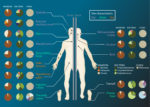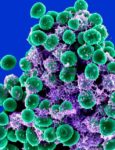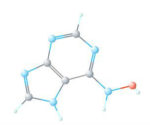
Researchers find that a bacterial species present on healthy skin produce a chemical that prevents skin cancer. Humans can be considered metaorganisms. Our bodies includes billions of microorganisms. There are microbes in the gastrointestinal (GI) system (referred to as the gut microbiome), on the skin, in the nose and eyes, and in the parts of the reproductive tracts that contact the outside world (Figure 1). Scientists and doctors realize that these microbes are not all harmful; many are beneficial. One of the latest examples comes from research into the microbes on human skin, which found that human skin has its own cancer-protective microbiome.

The composition of the microbial flora (which kinds of microbes and in what ratios) is affected by many factors, such as skin temperature, humidity, skin pH, the lipid content of skin, and compounds produced by skin that alter microbial growth. The most common kinds of bacteria on healthy, normal human skin are several strains of staphylococcal species, including Staphylococcus epidermidis and Staphylococcus hominis (Figure 2). The presence of some beneficial microbes, such as S. epidermidis and S. hominis, actually prevents the overgrowth of harmful bacteria and promotes the production of antimicrobial peptides and stimulates immune responses to reduce infection by harmful pathogenic microbes.
Nakatsuji and colleagues (from the University of California, San Diego, the National Institutes of Health, and The Jackson Laboratory for Genomic Medicine) found that S. epidermidis produced a chemical similar to one of the molecules (adenine) used to make DNA. The chemical is called 6-N-hydroxyaminopurine (6-HAP) (Figure 3). Because 6-HAP is structurally similar to adenine, it could inhibit DNA synthesis by interacting with the enzyme that makes DNA but not properly incorporating into the DNA molecule. Indeed, the authors found that 6-HAP inhibited DNA synthesis in a test tube and also inhibited DNA synthesis and proliferation of cultured cancer cells. Surprisingly, cultured normal human skin cells (keratinocytes) were not inhibited by 6-HAP, suggesting some selectivity for cancer cells. Compared to the cancer cells, the normal keratinocytes had much higher amounts of 2 proteins involved in metabolizing 6-HAP. Thus, the data indicated that keratinocytes inactivated this chemical; whereas the cancer cells did not.

Injecting 6-HAP into a mouse model of melanoma limited the growth of the tumors. More exciting was the finding that growing S. epidermidis that produced 6-HAP on the skin of mice protected them from developing skin tumors. In contrast, a strain of these bacteria that did not produce this chemical did not reduce the occurrence of tumors in mice. The mice with either kind of bacteria were exposed to a chemical carcinogen and ultraviolet light to trigger cancer at the site where the bacteria were present.
In addition to its other beneficial effects, the skin microbiome should be considered relevant to skin cancer risk. Just as the gut microbiome influences the response to cancer treatment and changes in the gut microbiome are associated with several types of GI cancer, skin cancer risk may be influenced by the skin microbiome. Not only may manipulation of the skin microbiome be a possible mechanism to reduce skin cancer, but knowledge of the mechanisms (production of 6-HAP in this case) may lead to new treatments or preventatives.
Related Reading
T. Nakatsuji, T. H. Chen, A. M . Butcher, L. L. Trzoss, S.-J. Nam, K. T. Shirakawa, W. Zhou, J. Oh, M. Otto, W. Fenical, R. L. Gallo, A commensal strain of Staphylococcus epidermidis protects against skin neoplasia. Science Advances 4, eaao4502 (2018). DOI: 10.1126/sciadv.aao4502 Full Text
A. P. Bhatt, M. R. Redinbo, S. J. Bultman, The role of the microbiome in cancer development and therapy. CA: A Cancer Journal for Clinicians 67, 326-344 (2017). DOI: 10.3322/caac.21398 Full Text
Cite as: N. R. Gough, Cancer-Protective Bacteria Found on Human Skin. BioSerendipity (6 March 2018). https://www.bioserendipity.com/cancer-protective-bacteria-found-on-human-skin/

